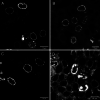Bioorthogonal Ligation-Activated Fluorogenic FRET Dyads
- PMID: 34861094
- PMCID: PMC9305863
- DOI: 10.1002/anie.202111855
Bioorthogonal Ligation-Activated Fluorogenic FRET Dyads
Abstract
An energy transfer-based signal amplification relay concept enabling transmission of bioorthogonally activatable fluorogenicity of blue-excitable coumarins to yellow/red emitting cyanine frames is presented. Such relay mechanism resulted in improved cyanine fluorogenicities together with increased photostabilities and large apparent Stokes-shifts allowing lower background fluorescence even in no-wash bioorthogonal fluorogenic labeling schemes of intracellular structures in live cells. These energy transfer dyads sharing the same donor moiety together with their parent donor molecule allowed three-color imaging of intracellular targets using one single excitation source with separate emission windows. Sub-diffraction imaging of intracellular structures using the bioorthogonally activatable FRET dyads by STED microscopy is also presented.
Keywords: FRET dyad; bioorthogonal; fluorogenic; multicolor; single excitation.
© 2021 The Authors. Angewandte Chemie International Edition published by Wiley-VCH GmbH.
Conflict of interest statement
The authors declare no conflict of interest.
Figures






References
-
- Wang L., Frei M. S., Salim A., Johnsson K., J. Am. Chem. Soc. 2019, 141, 2770–2781. - PubMed
-
- Grimm J. B., English B. P., Choi H., Muthusamy A. K., Mehl B. P., Dong P., Brown T. A., Lippincott-Schwartz J., Liu Z., Lionett T., Lavis L. D., Nat. Methods 2016, 13, 985–988. - PubMed
-
- Wang L., Tran M., D′Este E., Roberti J., Koch B., Xue L., Johnsson K., Nat. Chem. 2020, 12, 165–172. - PubMed
Publication types
MeSH terms
Substances
Grants and funding
LinkOut - more resources
Full Text Sources
Other Literature Sources

